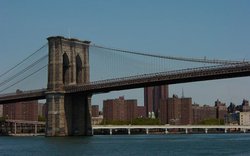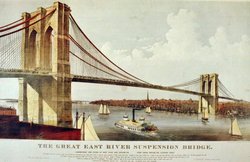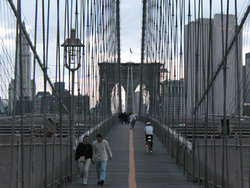Brooklyn Bridge
|
|
- This article is about the bridge in New York City. For the rock band, see Johnny Maestro & The Brooklyn Bridge.
BrooklynBridgeSchematic.jpg
Brooklyn-bridge-1890.png
Brooklyn_Bridge_cross_section.png
Brooklyn_Bridge_railroad.jpg
The Brooklyn Bridge (originally the New York and Brooklyn Bridge), one of the oldest suspension bridges in the United States, stretches 6016 feet (1834 m) over the East River from Manhattan to Brooklyn and was the first steel-wire suspension bridge in the world.
History
Construction began in 1869. The Brooklyn Bridge was completed fourteen years later and was opened for use on May 24, 1883. On that first day, a total of 1,800 vehicles and 150,300 people crossed. The bridge's main span over the East River is 1,595 feet (486 meters). The bridge cost $18 million to build and approximately 27 people died during its construction. A week after the opening, on May 30, a rumor that the Bridge was going to collapse caused a stampede which crushed twelve people.
At the time it opened, it was the longest suspension bridge in the world — fifty percent longer than any previously built, and has become a treasured landmark. Since the 1980s, it has been floodlit at night to display its architectural features. The architecture style is Gothic, with characteristic pointed arches above the passageways through the stone towers.
The bridge was designed by an architectural firm owned by John Augustus Roebling in Trenton, New Jersey. Roebling and his firm had built smaller suspension bridges, such as the John A. Roebling Suspension Bridge in Cincinnati, Ohio and the Waco Suspension Bridge in Waco, Texas, that served as the engineering prototypes for the final design.
As construction was beginning, Roebling's foot was seriously injured in an accident; within a few weeks, he died of tetanus. His son, Washington, succeeded him, but was stricken with caisson disease (decompression sickness), due to working in compressed air with the sandhogs, and was only capable of limited speech or movement. Washington's wife, Emily Warren Roebling, trained herself in engineering so she could communicate his wishes to the builders. Washington Roebling was unable to leave his home and watched the construction through a telescope.
At the time the bridge was built, the aerodynamics of bridge building had not been worked out. Bridges were not tested in wind tunnels until the 1950s - well after after the collapse of the Tacoma Narrows Bridge in the 1940s. It is therefore fortunate that the open truss structure supporting the deck is by its nature less subject to aerodynamic problems. Roebling designed a bridge and truss system that was six times as strong as he thought it needed to be. Because of this, the Brooklyn Bridge is still standing when many of the bridges built around the same time have vanished into history and had been replaced. This is also in spite of the nefarious substitution of inferior quality wire in the cabling supplied by a contractor - by the time it was discovered it was too late to replace the cabling that had already been constructed. Roebling determined that the poorer wire would leave the bridge four rather than six times as strong as necessary, so it was eventually allowed to stand.
At various times, the bridge has carried horses and trolley traffic; at present, it has six lanes for motor vehicles, and a separate level for pedestrians and bicycles. The two inside lanes of the lower level once carried elevated trains of the Template:BMT from Brooklyn points to a terminal at Park Row. Streetcars ran on what are now the two center lanes (shared with other traffic) until the Template:BMT stopped using the bridge in 1944, when they moved to the protected center tracks. In 1954, the streetcars also stopped running, and the bridge was rebuilt to carry six lanes of automobile traffic.
The Template:BMT bridge tracks were planned to connect to what is now the Nassau Street Line subway at Chambers Street to form part of the never-finished Centre Street Loop.
The bridge was placed on the National Register of Historic Places on June 17, 1977 and on March 24, 1983 the bridge was designated a National Historic Engineering Landmark.
The construction of the Brooklyn Bridge is detailed in a film by Ken Burns.
Cultural significance
BrooklynBridgeDetail.jpg
Contemporaries marvelled at what technology was capable of and the bridge became a symbol of the optimism of the time. John Perry Barlow wrote in the late 20th century of the "literal and genuinely religious leap of faith" embodied in the Brooklyn Bridge . . . the Brooklyn Bridge required of its builders faith in their ability to control technology." [1] (http://ftp.eff.org/pub/Publications/John_Perry_Barlow/HTML/brooklyn_bridge.html)
References to "selling the Brooklyn Bridge" abound in American culture, sometimes as examples of rural gullibility but more often in connection with an idea that strains credulity. For example, "If you believe that, I have a wonderful bargain for you . . ." However, see also Victor Lustig.
In his sophomore book The Bridge, Hart Crane begins with a poem entitled "Proem: To Brooklyn Bridge." The bridge was a source of inspiration for Crane and he owned different apartments specifically to have different views of the bridge.
The bridge was featured in the beginning of Sky Captain and the World of Tomorrow. The Brooklyn Bridge is featured in Disney's Oliver & Company as the bridge itself but with the automobile lanes covered. In the 1998 Godzilla movie, Godzilla attacked the bridge, the bridge's second and last tower is destroyed, and its train tracks are destroyed by Godzilla. The Brooklyn Bridge is featured at the end of Martin Scorsese's Gangs of New York. The bridge is featured in the Def Jam Fight For New York trailer. It can be destroyed in Godzilla: Save the Earth for PS2 and Xbox. The bridge is in the cover of Twin Towers. The bridge is featured in SimCity 3000 as the bridge but with opens, and in SimCity 4: Rush Hour as the "Medium Suspension" bridge type for avenues and highways. The bridge is also featured in Team America: World Police as the bridge itself.de:Brooklyn Bridge fr:pont de Brooklyn it:Ponte di Brooklyn nl:Brooklyn Bridge he:גשר ברוקלין
External links
- NYCroads.com - Brooklyn Bridge (http://www.nycroads.com/crossings/brooklyn/)
- Transportation Alternatives Fiboro Bridges - Brooklyn Bridge (http://www.transalt.org/bridges/brooklyn.html)
- The story of Brooklyn Bridge (http://www.cbsforum.com/cgi-bin/articles/partners/cbs/search.cgi?template=display&dbname=cbsarticles&key2=brooklyn&action=searchdbdisplay) - by CBS Forum (http://www.cbsforum.com/)
- Panorama of Brooklyn Bridge 1899 - Extreme Photo Constructions (http://www.dualmoments.com/Panorama/1903brooklyn.htm)
- Great Buildings entry (http://www.greatbuildings.com/buildings/Brooklyn_Bridge.html) for the Brooklyn Bridge
- American Society of Civil Engineers (http://www.asce.org/history/brdg_brooklyn.html)
- Brooklyn Bridge Webcam (http://www.earthcam.com/panasonic/new_york_bb.html)
- Railroad Extra - Brooklyn Bridge and its Railway (http://catskillarchive.com/rrextra/bbpage.Html)



